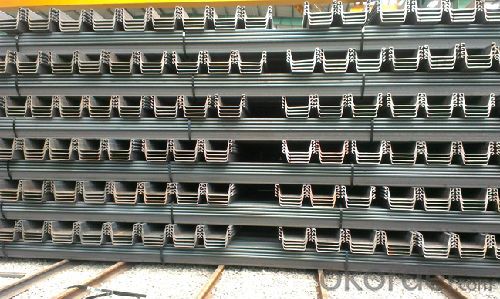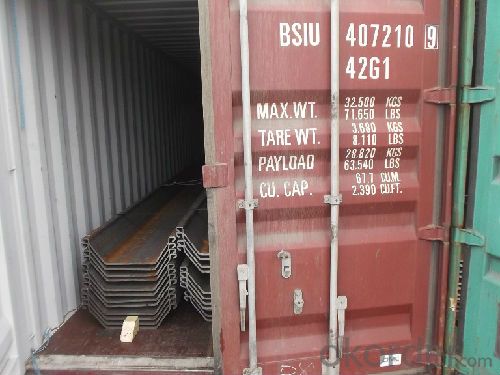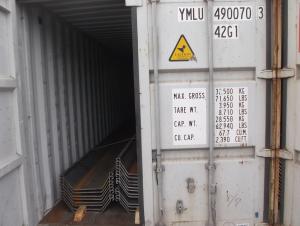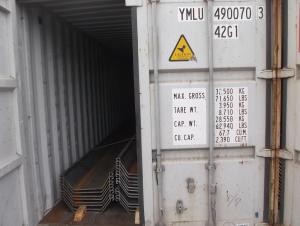U Steel Sheet Pile/ 400*100*8-10.5mm/ Export Steel Sheet Pile as Your Request
- Loading Port:
- China Main Port
- Payment Terms:
- TT or LC
- Min Order Qty:
- 200 Piece/Pieces m.t.
- Supply Capability:
- 10000 m.t./month
OKorder Service Pledge
OKorder Financial Service
You Might Also Like
Quick Details Steel Sheet Pile
Place of Origin: China (Mainland)
Model Number:SD400
Material: Steel
Product name: Steel Sheet Pile
Steel sheet pile type: U-type
Steel sheet pile material: SY295
Steel sheet pile width: 400mm
Steel sheet pile height: 100mm
Steel sheet pile thickness: 10.5mm
Steel sheet pile length: 6m or 12m
Steel sheet pile loading: container , 20 ft or 40GP
Steel sheet pile used: temporary earth-retaining,temporary cofferdam works
Steel sheet pile weight: 60kgs / m
Packaging & Delivery
| Packaging Details: | packaging :by bulk . loading : container 20ft or 40GP |
|---|---|
| Delivery Detail: | stock ( more type has stock ) |
Specifications
Steel Sheet Pile 400*100*10.5mm
U Steel Sheet Pile
temporary earth-retaining/temporary cofferdam works/permanent structures
Export U Steel Sheet Pile 400*100*10.5mm
Product Description
Steel Sheet Pile Usage
emporary earth-retaining, temporary cofferdam works and permanent structures
Steel Sheet Pile Type :
Type | Size | Per piece | Per Meter of pile wall | ||||||||
Width | Height | Thickness | weight | section area | section moment | section modulus | section area | section moment | section modulus | weight | |
mm | mm | mm | kgs /m | cm2 | cm4 | cm3 | cm²/m | cm4/m | Cm³/m | kg/m² | |
SD400/85-8 | 400 | 85 | 8 | 35.5 | 45.21 | 598 | 88 | 113 | 4500 | 529 | 88.80 |
SD400/100-10.5 | 400 | 100 | 10.5 | 48 | 61.18 | 1240 | 152 | 153 | 8740 | 874 | 120.10 |
SD400/125-13 | 400 | 125 | 13 | 60 | 76.42 | 2220 | 223 | 191 | 16800 | 1340 | 149.90 |
SD400/150-13.1 | 400 | 150 | 13.1 | 58.4 | 74.4 | 2790 | 250 | 186 | 22800 | 1520 | 146.00 |
SD400/170-15.5 | 400 | 170 | 15.5 | 76.1 | 96.99 | 4670 | 362 | 242.5 | 38600 | 2270 | 190.40 |


Packaging & Shipping
Packing : it use container to load , 6M use 20ft container ; 12M use 40GP container .
Our Services for Steel Sheet Pile
World leading manufacturer of cold-formed Sheet Pile.
Factory got a variety of quality certification : ISO9001:2000; ISO9001:2008.
Our products popular applicated for temporary earth-retaining, temporary cofferdam works and permanent structures
- Q:Are steel sheets prone to warping or distortion?
- Yes, steel sheets are prone to warping or distortion under certain conditions such as high temperatures or uneven cooling, excessive load or stress, or improper handling and storage.
- Q:What are the weight calculations for steel sheets?
- The weight calculations for steel sheets depend on the dimensions and thickness of the sheet. The weight can be calculated using the formula: weight = length x width x thickness x density of steel. The density of steel is generally taken as 7850 kg/m^3.
- Q:Can steel sheets be used for solar panel mounting systems?
- Yes, steel sheets can be used for solar panel mounting systems. Steel is a durable and strong material that provides structural support for the panels. It is commonly used in various mounting systems due to its ability to withstand the weight and forces exerted by solar panels, ensuring their stability and longevity.
- Q:Can steel sheets be used for furniture manufacturing?
- Yes, steel sheets can be used for furniture manufacturing. Steel is a versatile and durable material that can be shaped and formed into various furniture components such as table legs, frames, and shelves. Steel sheets are commonly used in the production of modern and industrial-style furniture due to their strength, stability, and sleek appearance. Additionally, steel can be easily welded, bent, or cut to create customized furniture designs. The use of steel sheets in furniture manufacturing also provides advantages such as resistance to corrosion, fire, and pests. Therefore, steel sheets are a popular choice for furniture manufacturers looking to create contemporary, sturdy, and long-lasting furniture pieces.
- Q:How long do steel sheets typically last?
- Steel sheets typically have a lifespan of 20 to 30 years, although this can vary depending on factors such as the quality of the steel, maintenance, and exposure to environmental conditions.
- Q:What is the process of galvalume coating on steel sheets?
- The process of galvalume coating on steel sheets involves a continuous hot-dip process. First, the steel sheets are cleaned and then immersed in a bath of molten zinc-aluminum alloy, which typically consists of 55% aluminum, 43.5% zinc, and 1.5% silicon. The steel sheets are carefully passed through the molten bath, ensuring that both sides are evenly coated. As the sheets are withdrawn from the bath, excess alloy is removed by air knives, leaving a thin layer of the galvalume coating on the steel surface. This coating provides excellent corrosion resistance and durability to the steel sheets.
- Q:Do steel sheets have any magnetic properties?
- Indeed, magnetic properties are possessed by steel sheets. Steel, which is an alloy primarily composed of iron, carbon, and other elements, exhibits ferromagnetism. This characteristic enables it to be magnetized and attract magnets. Nevertheless, the extent of magnetism in steel can differ based on its composition and processing. Certain steel alloys can be effortlessly magnetized and retain their magnetism even after the removal of the applied magnetic field, while others may display lower magnetic properties. Furthermore, the presence of impurities and the specific heat treatment process can also impact the magnetic properties of steel. In summary, steel sheets can display magnetic properties; however, the degree of magnetism may fluctuate depending on the specific type and composition of the steel.
- Q:What are the different thickness tolerances for steel sheets?
- The different thickness tolerances for steel sheets can vary depending on the specific grade and manufacturing standards. However, commonly used thickness tolerances for steel sheets range from +/- 0.001 inches to +/- 0.030 inches, depending on the desired precision and application requirements.
- Q:How are steel sheets protected during transportation by sea?
- Steel sheets are protected during transportation by sea through various measures to ensure their safety and prevent damage. One of the most common methods used is the application of a protective coating on the steel sheets. This coating acts as a barrier against moisture and saltwater, which are the primary causes of corrosion during sea transportation. The coating can either be a temporary solution, such as a layer of oil or wax, or a more permanent solution, such as a layer of paint or zinc. Additionally, steel sheets are often packaged in bundles or placed in shipping containers to provide added protection. These bundles are secured with straps or wires to prevent movement and potential damage during rough sea conditions. The shipping containers themselves are designed to withstand the rigors of sea transportation and protect the steel sheets from exposure to the elements. Furthermore, steel sheets may be wrapped in plastic or other waterproof materials to provide an extra layer of protection against moisture. This helps to prevent the sheets from coming into direct contact with seawater or rain, reducing the risk of corrosion. During loading and unloading, proper handling techniques are employed to minimize the risk of damage. Cranes or forklifts are used to lift and move the steel sheets carefully, ensuring that they are not dropped or subjected to excessive force that could cause dents or bends. Overall, a combination of protective coatings, secure packaging, and proper handling techniques are employed to safeguard steel sheets during transportation by sea, reducing the chances of damage and ensuring that they arrive at their destination in optimal condition.
- Q:Can the steel sheets be used for insulation purposes?
- Typically, steel sheets are not employed for insulation purposes. Due to its high conductivity, steel easily transfers heat and cold. Consequently, it is ill-suited for insulation as it fails to effectively hinder the transfer of thermal energy. Conversely, insulation materials are explicitly designed to minimize heat transfer and enhance energy efficiency in buildings and other structures. Foam, fiberglass, and cellulose are examples of common insulation materials that exhibit significantly greater resistance to heat flow than steel.
1. Manufacturer Overview |
|
|---|---|
| Location | |
| Year Established | |
| Annual Output Value | |
| Main Markets | |
| Company Certifications | |
2. Manufacturer Certificates |
|
|---|---|
| a) Certification Name | |
| Range | |
| Reference | |
| Validity Period | |
3. Manufacturer Capability |
|
|---|---|
| a)Trade Capacity | |
| Nearest Port | |
| Export Percentage | |
| No.of Employees in Trade Department | |
| Language Spoken: | |
| b)Factory Information | |
| Factory Size: | |
| No. of Production Lines | |
| Contract Manufacturing | |
| Product Price Range | |
Send your message to us
U Steel Sheet Pile/ 400*100*8-10.5mm/ Export Steel Sheet Pile as Your Request
- Loading Port:
- China Main Port
- Payment Terms:
- TT or LC
- Min Order Qty:
- 200 Piece/Pieces m.t.
- Supply Capability:
- 10000 m.t./month
OKorder Service Pledge
OKorder Financial Service
Similar products
New products
Hot products
Related keywords




































